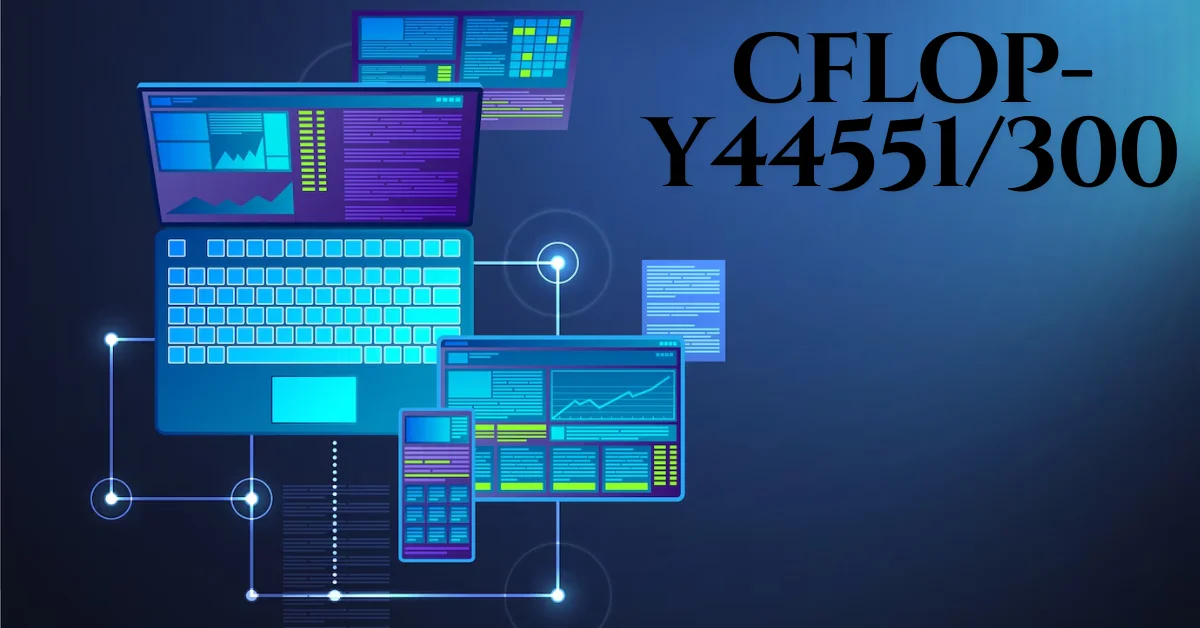INTRODUCTION TO cflop-y44551/300
In a world overflowing with technological innovations, how a product is named can be just as crucial as its functionality. Enter the curious case of cflop-y44551/300—a name that evokes intrigue and questions. But what does it signify? As we journey through the realm of technology naming, we’ll unravel why names matter so much in this sector. From historical roots to modern trends, your understanding of technology nomenclature will deepen, revealing how impactful a solid name can be for consumers and brands alike. Buckle up; it’s time to explore the fascinating landscape of tech names!
The importance of a good technology name
A well-crafted technology name serves as the first impression for consumers. It can capture attention and spark curiosity instantly. When a name resonates, it creates an emotional connection with potential users.
Consider how easily memorable names can encourage word-of-mouth recommendations. A catchy title rolls off the tongue and sticks in our minds, making it more likely that people will share their experiences.
Moreover, a good name conveys purpose and functionality at a glance. It should hint at what the product does or its unique features without overwhelming jargon.
In today’s competitive landscape, differentiation is key. A distinctive name helps set a product apart from countless competitors vying for consumer attention. With so much choice available, a strong name could be the deciding factor that leads to adoption over similar technologies.
What is the meaning of cflop-y44551/300
Understanding the meaning behind a technology name can be fascinating. Take “cflop-y44551/300,” for instance. At first glance, it appears to be a random alphanumeric combination.
However, every part of this name might hold significance. The prefix “cflop” could hint at specific functions or features, perhaps relating to performance metrics in computing environments.
The string “y44551” may denote a particular version or model number. This helps differentiate it from other products in a crowded market.
The “/300” could signify scalability or capacity—indicating how powerful this technology is meant to be compared to its predecessors.
Each element works together, creating an identity that communicates expectations and functionalities even before consumers interact with the product itself.
The history and evolution of technology naming
The journey of technology naming has been fascinating. In the early days, names were often descriptive and straightforward. Think about devices like the “telephone” or “television.” These terms conveyed exactly what they did.
As technology advanced, so did the complexity of its products. The rise of software in the 1980s introduced more abstract names, such as “Windows” or “Mac OS.” These names evoked a sense of user experience rather than functionality alone.
In recent years, tech brands have embraced creativity and uniqueness. Names like “iPhone” or “Galaxy” not only differentiate themselves but also evoke emotion and aspiration among consumers.
With globalization in mind, companies now strive for universal appeal. This evolution reflects how deeply intertwined branding is with cultural resonance and market strategy in today’s fast-paced world. Each name tells a story that can shape perceptions before users even engage with the product itself.
Common trends in technology names
Technology names often follow intriguing trends that reflect innovation and market positioning. One common trend is the use of prefixes or suffixes that evoke familiarity, such as “e-” for electronic or “-ify” for simplification. These elements create a sense of modernity.
Another noteworthy pattern involves blending words to form portmanteaus. This technique not only saves space but also captures multiple ideas in one catchy name, like “Infotech” combining information and technology.
Abbreviations are also prevalent; they offer brevity while maintaining memorability. Think about well-known names like AI for artificial intelligence.
Moreover, many tech brands gravitate towards numeric combinations to signify models or versions. The cflop-y44551/300 could be seen as an example where numbers add a layer of specificity essential in distinguishing products within crowded markets.
There’s an emerging trend toward more human-centric naming styles—names that resonate emotionally with consumers rather than just being technical jargon.
The impact of a good or bad technology name on consumers
A technology name can make or break consumer perception. A catchy, memorable name like cflop-y44551/300 can spark curiosity and interest. It stands out in a crowded market, drawing attention and prompting further exploration.
Conversely, a poorly chosen name may confuse potential users. If it’s too complex or lacks relevance, consumers might overlook the product entirely. First impressions matter significantly; an uninspiring label can signal mediocrity.
Moreover, names influence trust and credibility. A professional-sounding title often instills confidence in quality and reliability. Consumers are more likely to invest time and resources into products that resonate positively with their expectations.
In the tech realm, where innovation thrives on perception as much as performance, naming strategies play a pivotal role in shaping user engagement. The right choice fosters loyalty while the wrong one risks alienating key demographics altogether.
Strategies for creating effective technology names Of cflop-y44551/300
Creating effective technology names involves a blend of creativity and strategy. Start by focusing on simplicity. A name that is easy to pronounce can foster better recall among consumers.
Think about the emotional connection you want your audience to have. Names like “cflop-y44551/300” may seem complex but can be broken down into memorable parts, emphasizing innovation.
Incorporate descriptive elements that hint at functionality. This provides clarity while sparking curiosity about the product’s capabilities.
Consider cultural implications as well; what sounds intriguing in one language might not resonate in another. Test potential names across different demographics for broader appeal.
Ensure availability online. Check domain registrations and social media handles to secure your brand identity before launching your new technology product into the market.
Conclusion: Why a well-thought-out name is crucial for the success of a new technology product
A well-thought-out name plays a pivotal role in the success of any new technology product, including those like cflop-y44551/300. It serves as the first point of contact between consumers and the innovation itself. A compelling name can evoke curiosity, suggest functionality, and resonate with target audiences.
Consider the emotional response a name elicits. If it’s catchy or descriptive, it can stick in people’s minds. This memorability is crucial when consumers are inundated with options in today’s tech landscape. An effective name not only communicates what the product does but also builds brand loyalty over time.
The journey from concept to consumer starts with branding that feels intentional and thoughtful. Companies that invest time into naming their technologies tend to see better engagement rates and stronger market presence compared to those who rush through this process.
A strong technology name acts as an anchor for your brand identity and sets expectations for performance and value. As innovation continues at breakneck speed, having a distinct yet relatable identity will ensure products stand out amid fierce competition.
FAQs
What is cflop-y44551/300?
It refers to a specific model or configuration code used by manufacturers to categorize technology, software, or hardware products.
Why is cflop-y44551/300 important?
It helps differentiate versions, track functionalities, and simplify the categorization of products in the tech industry.
Is cflop-y44551/300 a product name?
No, it’s a model or configuration code, often part of a larger product identification system.
How do manufacturers use cflop-y44551/300?
Manufacturers use it for organizing, naming, and distinguishing different product versions and configurations.
Can cflop-y44551/300 represent multiple products?
Yes, the code can refer to different products or versions within a product line depending on its specific configuration.

